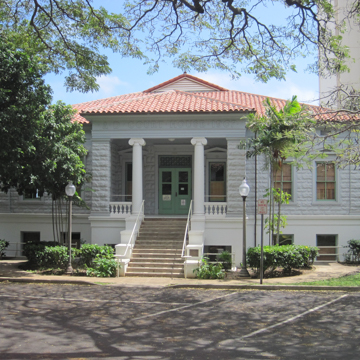With the passage of the County Act of 1905, Wailuku was named the county seat of Maui, over Lahaina, the former capital of the Hawaiian kingdom. Two years later the territorial legislature appropriated $25,000 for the construction of this building, which housed county offces as well as the courts. Majestically rising from a below-grade concrete first story, this Beaux-Arts-inspired courthouse features a projecting Ionic-columned portico and cast-concrete pediments above the windows. Its hollow-concrete-block walls mimic dressed bluestone and were cast on Maui utilizing forms specially made for the project. The building was also the first in Wailuku to be wired for electricity. Although installed at the time of its construction, the courthouse's tenants did not benefit from this now indispensable feature until 1912 when electricity was finally introduced to the town. Originally the building had a flat roof, but the red tile hipped roof with gablet appeared in the late 1920s, responding to its more inviting, red-roofed neighbors. A renovation by Spencer-Mason Architects in 1993 retained much of the interior woodwork. The building now houses the county prosecutor's offce and a judicial museum.
You are here
Maui County Courthouse
If SAH Archipedia has been useful to you, please consider supporting it.
SAH Archipedia tells the story of the United States through its buildings, landscapes, and cities. This freely available resource empowers the public with authoritative knowledge that deepens their understanding and appreciation of the built environment. But the Society of Architectural Historians, which created SAH Archipedia with University of Virginia Press, needs your support to maintain the high-caliber research, writing, photography, cartography, editing, design, and programming that make SAH Archipedia a trusted online resource available to all who value the history of place, heritage tourism, and learning.





















